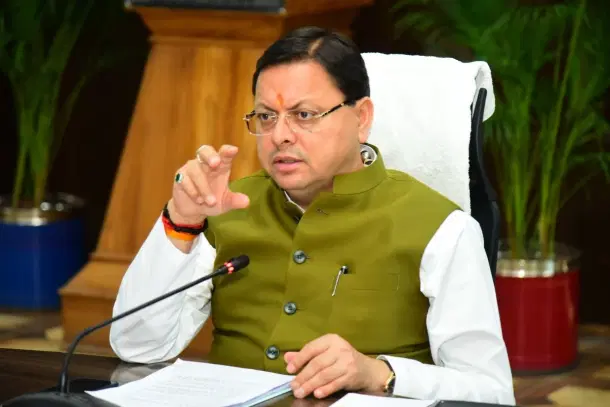Legal
How Uttarakhand's Minority Education Bill Ends Madrasa Exceptionalism And Congress-Era Appeasement
Nandini Mishra
Sep 04, 2025, 01:51 PM | Updated 01:51 PM IST
Save & read from anywhere!
Bookmark stories for easy access on any device or the Swarajya app.


The Uttarakhand Legislative Assembly in a first of its kind move passed the Minority Educational Institutions Bill, 2025 in its monsoon session. The Bill is an attempt to reform the policy framework under the previous Congress Government which focused heavily on the madrasas leaving other minorities unrecognised.
The Bill will repeal the Uttarakhand Madrasa Education Board Act, 2016 and Uttarakhand Non-Government Arabic and Persian Madrasa Recognition Rules, 2019 with effect from 1 July 2026. What makes this Bill different from the predecessor legislation is its inclusive and corrective nature. The Uttarakhand Bill recognises other minority communities in addition to Muslims and extends the benefit of minority status to include Sikh, Jain, Christian, Parsi and Buddhist which were earlier sidelined during the Congress Government’s tenure.
While the inclusive nature of the Bill is a key aspect of it, the fundamental aim is to address the persistent deficiencies that have plagued the minority education institutions in Uttarakhand. The previous legislations created a system of regulation akin to a school system for madrasas but left the other religious minorities completely outside the ambit of legislative recognition and regulation.
Legacy Of Appeasement
The roots of the deficiencies in madrasas and disregard of non-Muslim minority communities trace back to the legacy of appeasement practised during the Congress administration in the state. Instead of reforming the educational institutions, it chose inaction and vote-bank politics, and created a system riddled with inefficiency and lost opportunities. The Congress Government refused to focus on improving the standards of education and ensuring uniformity due to fear of drawing resentment from Islamist fundamentalists.
As a result, a number of issues surfaced within the madrasas. The urgency for reforms became imperative precisely for these problems which included irregularities in scholarship distribution, discrepancies in mid-day meal schemes, and lack of transparency currently plaguing the madrasa management in Uttarakhand. Furthermore, the mushrooming of unregistered madrasas in sensitive border areas raised national security concerns as many of them were operating without authorisation, with unauthorised construction, or under suspicion of promoting radical ideologies under the guise of education.
The concerns raised above were also validated by a report of the National Commission for Protection of Child Rights (NCPCR) which revealed deep structural issues in the functioning of madrasas. The report shed light on the core issues with the function of madrasas: an overwhelming focus on religious instruction that emphasised the supremacy of Islam, only token inclusion of NCERT books, outdated teaching practices without experiential learning and social isolation that cut students off from mainstream opportunities.
To make matters worse, exemptions from the Right to Education Act have meant children also miss out on mid-day meals, trained teachers, and the structured protections that are otherwise guaranteed under Articles 21 and 21A of the Constitution.
The trend of internal mismanagement, structural issues and pedagogy exposes a deep-rooted neglect of educational institutions under the INC Government where appeasement of the Muslim community was prioritised over the upliftment and reformation of all minority communities. This is where the BJP Government stepped in to address the long-standing abandonment of other communities by the Congress and passed the Uttarakhand Minority Educational Institutions Bill, 2025 which enables all the six minority communities in the state to manage their own educational institutions.
Corrective Vision of BJP Government
The Bill takes a multi-faceted approach to curb the radicalism disguised as education. Firstly, it provides for the study of Gurumukhi and Pali languages to promote inclusivity. Secondly, it establishes a standardised body called Uttarakhand State Authority for Minority Education (USMEA) for overseeing the management of all the minority institutions.
This is a major shift from the Board constituted under the 2016 Act, which was heavily dominated by religious leaders. To reform this, the Bill creates a new 12-member body called USMEA. It will include six academicians from each minority community and a social worker as ex-officio members to ensure administrative accountability and transparency.
As a quality control measure, the Bill also prescribes mandatory affiliation with the Uttarakhand Board of School Education (UBSE) to ensure uniform management and standardisation of curriculum. This directly tackles the concerns highlighted by the NCPCR report. Under the new framework, the rules framed by the USMEA and UBSE will be applicable in all academic, administrative and financial matters of the minority institutions thereby promoting transparency, consistency and quality in education.
Analysing the Provisions of the Bill vis-à-vis the Constitutional Principles
Any reform in the realm of minority affairs falls in a sensitive domain that inevitably intersects with constitutional protection of minority rights. However, as opposed to the claims made, the Bill is actually rooted in the constitutional balance between the rights of minorities to establish and administer educational institutions, and the State’s responsibility to ensure academic excellence, transparency, and accountability. A column published on Bar and Bench makes several claims which are based on misinterpretation of constitutional principles.
Autonomy of minority institutions
Article 30 of the Constitution protects the rights of minorities to administer institutions of their choice. However, this right is not absolute. The Supreme Court in DAV College v. State of Maharashtra and Ahmedabad St. Xavier’s College v. State of Gujarat emphasised that while minorities enjoy autonomy in administration, such autonomy cannot extend to maladministration. In other words, the Government can create regulations in order to maintain the educational standards as long as it is reasonable.
This constitutional vision was further advanced in Bihar State Madarsa Education Board v. Madarsa Hanfia Arabic College, where the Court clarified that appointing experts who are not from the minority community is valid if it improves efficiency and academic standards. The Uttarakhand Bill works on this principle and establishes USMEA which is an inclusive and representative body to prevent mismanagement as was seen under the previous frameworks. The USMEA does not impact the minority rights in any manner. Rather, it ensures that all the minority institutions are at par with state standards and lays down the criteria for qualifications, infrastructural requirements and financial transparency.
The column claims that the measures contained within the Bill are not proportionate and makes a reference to the 2016 Act. However, even the provisions within the previous legislation gave sweeping powers to the State Government along with the Board constituted under the Act to refuse or withdraw recognition.
Limitation upon the religious freedom
The Bill strives to create a careful balance between preservation of religious freedom and maintenance of uniform educational standards. Article 25 and 26 safeguard the right to profess and practise religion but both are subject to reasonable restrictions. In Anjum Kadari v. Union of India, the Supreme Court drew an important distinction between religious education which is permissible in a minority institution and religious instruction and indoctrination which is restricted by virtue of Article 28.
Seen in this light, the Uttarakhand Bill aligns with this vision and does not curtail religious teaching but merely regulates the scope by requiring adherence to NCERT and state board standards. Far from the claims that the Bill erodes minority rights, it actually ensures that freedom of religion coexists with standardised education across institutions.
Integration And Reformation
The column published on Bar and Bench argues that the Bill leads to forced assimilation and the erasure of identity and further claims that madrasas are survival institutions that were born out of necessity where State schools were absent, and that the Bill undermines this by imposing a uniform licensing system for all minority institutions which compromises administrative autonomy.
However, such claims are misleading. Rather than focusing on modernising and improving the standards of education for all minorities, the opposition chose an easy route of appeasement of Muslims, thereby promoting outdated structures that left the community educationally backward, socially isolated and vulnerable to exploitation while the other minority communities remained unrecognised. Furthermore, the Congress never undertook the actual task of monitoring how these institutions were run, which also led to the mushrooming of several unauthorised madrasas raising national concerns.
The reference made to the report of the Sachar Committee by the column is equally misplaced. A critical reading of the report shows that the very reason for Muslim educational backwardness, with literacy nearly twenty percentage points below the national average, was their forced dependence on outdated madrasas. The Uttarakhand Bill addresses this by ensuring access to NCERT-based curricula, modern subjects for minority students, and creating pathways to economic mobility, without losing cultural identity.
The Bill by the State Government is not a mere token but rooted in empowerment of all the minority communities of Uttarakhand. The column questions the provision for protection of communal and social harmony and calls it vague by referring to Shreya Singhal v. Union of India wherein Section 66A of the IT Act was struck down for being vague. However, the comparison between the terms used in the Bill and the judgement is wholly misplaced as the void for vagueness doctrine mentioned in the judgement is only applicable for criminal offences.
The clause under the Uttarakhand Bill is not a punitive measure which requires a clear definition but rather a protective measure. The Courts in several judgements have upheld similar clauses as the constitutional jurisprudence allows the State to frame criteria for ensuring regulation.
Furthermore, the clause seeking protection of communal and social harmony demonstrates that its objective is not to efface diversity but to secure an environment in which different communities can learn together while preserving their cultural distinctiveness. This is in line with the true spirit of secularism as advocated by BJP unlike the token measures by the opposition.
The Bill embraces an integrated model of secularism: one in which shared curricula and standards create common ground for students from all backgrounds, while minority institutions retain their unique ethos through religious and cultural education.
This approach moves beyond a separate but equal paradigm and instead fosters social cohesion, preparing students for equal participation in modern economic and civic life. A fragmented system that isolates communities may protect identity superficially but risks entrenching disadvantage. A system of integration, by contrast, safeguards identity while opening doors to broader opportunities.





